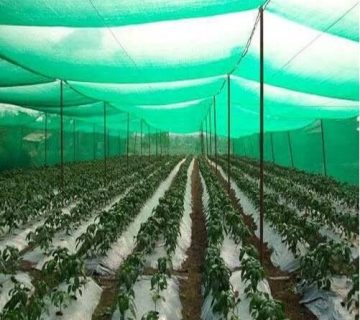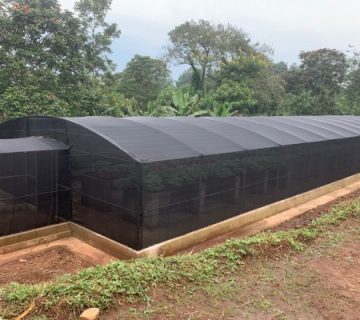In this blog, we will talk about the best colour shade cloth for orchids. Orchids, which thrive in partially shaded areas, are some of the world’s most stunning and refined plants. However, to flourish and develop normally, they have unique needs. Some things that help most of them grow better are shade nets.
Protecting plants from the sun’s rays and the burns and stress that can result from prolonged exposure to the sun is a primary reason why shade nets are so useful in outdoor and greenhouse settings. Shade net has two main aspects. One is shading percentage, and the other is shade net color. Before getting to our topic, first, let’s see whether all orchids prefer shade.
Do orchids prefer shade?
It is common knowledge that orchids require partial shade to thrive. An orchid suffers severe damage when placed in the path of the summer’s blazing rays.
To bloom, orchids need exposure to light, but different varieties have different light needs. Some orchids do best in full sun, while others do better in partial shade. Most orchids are more intermediate in their light needs, preferring either dappled or indirect sunlight. Let’s see what the proper light exposure for these flowers is.
What light exposure is best for orchids?
The ideal amount of light for orchids is 6-8 hours of bright, indirect sunlight per day. Depending on the type of orchid, the best location for it is an east or west-facing window with diffused light.
Remember that sunlight is the most crucial element for thriving orchids producing gorgeous, long-lasting flowers. Finding the optimal spot for your orchid may require a few tries as you experiment with different lighting arrangements.
Selecting an ideal environment for your orchid is crucial to health and growth. Orchids make a great, eye-catching, low-maintenance house plant when given strong, indirect sunshine from an east- or west-facing window. Now let’s get to our main topic.
The Proper Percentage of shade cloth for orchids
Different shade nets are available with varying shading factors to block more radiation and lower the temperature of the air, soil, and plants within the shade house.
Apart from choosing the best colour shade cloth for orchids. Orchids need specific amounts of shade, which can be determined by the latitude and altitude of their growing environment.
The density of knitted or woven shade fabric is expressed as a percentage, indicating the amount of sunlight blocked by this cloth. There are many different densities available, including 30%, 55%, 63%, 75%, 80%, and 90%. Vegetables grown in cloth with a shade factor of 30% should be fine.
Many common plant types, including nursery stock, pot plants, caladiums, lettuce, and others, benefit from partial shade and can thrive when grown under 50% shade cloth. Orchids, on the other hand, are shade-adapted plants that require 75-80% shade cloth for adequate coverage.
We’ve already established that your geographic location is crucial when picking out the appropriate shade fabric. In Australia, summer temperatures are often greater in the north than in the south. Orchid growers in North Queensland and the Northern Territory need to use shade cloth with a higher density (75-80%) because of the intense sunlight in these places.
Orchid species have widely varying light requirements. Some orchids thrive in warm environments, some that require intermediate temperatures, and those that prefer cooler temperatures. The Vanda orchid, for instance, is endemic to the Philippines’ tropical rainforest and requires intense lighting to thrive.
Most orchid species, including Paphiopedilums, Macodes, Bulbophyllum, and Phalaenopsis, need between four and six hours of sunshine daily, at 30 to 60 percent brightness. Therefore, 75-80% shade cloth is required to satisfy this light intensity requirement for these orchids.
Orchids that prefer bright light, such as Dendrobium, Cattleya, and Oncidium, require shade cloth with a partial blockage factor of 50% or less.
Orchids that require low levels of light to thrive do so in the shade of trees. Orchids of the Macodes, Paphiopedilums, Phalaenopsis, and Bulbophyllum varieties are included. They do best with 4 to 6 hours of daily light at a 30% to 60% intensity. Growers can block off this light by using either a green shade cloth (at 75%-80% transparency) or two or three layers of darker shade cloth (at 30% transparency). Now’s the time to review the best colour shade cloth for orchids.
List of Best colour shade cloth for orchids
Orchids and other shade-loving plants thrive in shady conditions. The size and shape of the leaves are obvious indicators of this change. In addition, the plant extends upward and gains additional nodes.
Most shade nets are created from UV-resistant materials that disperse the sun’s rays. The optimal growing environment is created by a shade net that diffuses light as much as possible without changing its spectrum. Shade cloth color is an essential factor to think about. Which color would you recommend I pick?
The basic idea is that white shade fabric will reflect the sun’s rays while a dark color will soak them up. Orchids can benefit from a wide range of shade cloth colors. Let’s examine the best colour shade cloth for orchids thoroughly:
Silver
Since silver Aluminet shade fabric scatters the most light without changing the hue of the light reaching the plant, it is the optimal choice for orchids. Because of their capacity to dissipate heat, they are ideally suited for use as a roofing material
White
When it comes to blocking out sunlight, white shade cloth is our second-best pick because it does not completely change the light spectrum.
Red
Plants grown in a shade house using this shade fabric color tend to blossom earlier than they would otherwise. Red-colored orchids grown under a shade cloth tend to have extra-large leaves. They also have unusually thick and tall stalks.
Low-light orchid species Phalaenopsis has been studied in terms of light spectrum management via colored nets to regulate development and flowering. The flowering and biomass production phases of moth orchids were analyzed concerning the effects of various shade cloth colors. According to the results of this research and other trials, red shade cloth results in a higher number of blooms than either blue or black cloth.
Blue
A blue-shade cloth acts as a diffuser, reducing the intensity of the sunlight. However, they are typically the ones responsible for producing solar heat. The orchids grown under such a canopy have larger leaves and deeper roots.
Conclusion
These were our list of best colour shade cloth for orchids. Remember, Orchids that prefer partial shade require special attention and a clean, humid atmosphere to flourish. Choosing the right shade cloth color and amount of light exposure is essential for optimal growth.




No comment